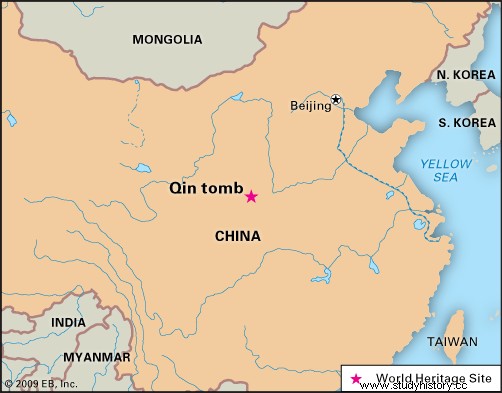Qin Grab , Wade-Giles Romanization Ch'in , also Named the mausoleum of the First Qin Emperor , important Chinese archaeological site near the ancient capital Chang'an , Shaanxi Sheng (province), China , now near the modern city Xi'an . It is the tomb of the first sovereign Kaisers, Shihuangdi the Qin - Dynasty (221-207 vdZ ) that unifies the empire began with the Construction of Great Wall of China , and for the death prepared , by a 20 square mile (50 square kilometer) tomb construction connection , the treasures of which only came to light some 2,100 years after his death.
 Britannica Quiz Exploring China:Fact or Fiction? Does China have about half the world's population? Is China the most densely populated country on earth? Test the density or sparsity of your knowledge of China with this quiz.
Britannica Quiz Exploring China:Fact or Fiction? Does China have about half the world's population? Is China the most densely populated country on earth? Test the density or sparsity of your knowledge of China with this quiz. In March 1974, a labor brigade of farmers drilling a well discovered an underground chamber where archaeologists later found an army of about 8,000 people found Terracotta Soldiers (composed of separately fired sections but with individually detailed faces) and horses and ornate wooden chariots (now resolved) and Bronze ; Iron farm devices ; Bronze and Leather bridle; Items from silk , linen , Jade and bones ; and such weapons as bows and arrows, spears, and swords cast from an unusual 13-element alloy that remain shiny and sharp today. The sound Figures that were once brightly painted with mineral paints have been combined into a specific military formation - a configuration of avant-garde archers and crossbowmen, outer files of archers, squads of infantry and charioteers, and an armored rearguard - to conform with military regulations of the time. Three nearby chambers - one with more than 1,300 ceramic figures depicting a smaller, complementary force of foot soldiers, chariots and cavalry, one with 68 members of what was probably an elite commando unit, and an empty one - were also discovered in the chamber 1970s. Buried over and around many of the broken figures are the remains of wooden roofs, which may have collapsed due to a fire shortly after the Emperor's death. These four so-called Xi'an excavations are covered with a canopy and, as the archaeologists' work progresses, serve as a unique on-site museum for Qin figures; A new exhibition hall was opened over one of the pits in 1994.
The buried army faces east and is ready for battle about three quarters of a mile from the outer wall of the actual Grabes removed . She guards them from Shihuangdi's former main antagonists who had come from that direction. The remains of seven people (possibly the Emperor's children) were found in nearby pits, an underground stable full of horse skeletons, a collection of half-sized bronze chariots, 70 individual burial grounds, a zoo for exotic animals and others Artifacts .
The tomb itself, which may have been looted shortly after its completion, has not been excavated. It lies within an inner wall and beneath a four-sided pyramidal mound, originally designed as a low, wooded mountain. The interior is said to be a vast underground palace that took about 700,000 conscripts more than 36 years to complete. The Historian Sima Qian ( c . 145- . C 87 vdZ ) wrote:
The compound was declared a UNESCO World Heritage site in 1987. Archaeological excavations on the site continued into the 21st century, and archaeologists anticipated that it would take years to unearth the entire tomb complex.

The region surrounding the Qin tomb holds the mausoleums of several other ancient Chinese rulers, including those of Taizong, second emperor (626–649 ce) of the Tang dynasty, and the Han emperor Wudi (141–87 bce).






